All About Diamonds
Birthstones
Precious Metals
Anniversary Guide
THE DIAMOND
The word diamond comes from the Greek, “Adamas”, or Latin’s “Diamas”, both of which mean unconquerable. The fact that diamonds are almost indestructible makes them the perfect symbol of everlasting love. The Greeks believed that the fire in a diamond represented the constant flame of love.

THE NATURAL DIAMOND
“A Diamond is a natural mineral consisting essentially of pure carbon crystallized with a cubic structure in the isometric system. Its hardness in the Moh’s scale is 10; its specific gravity is approximately 3.52; it has a refractive index of 2,42 and it can be found in many colours.” Definition supplied by the DTC.
A gemstone of this description that has been mined from the earth is the only gem that can be called a Diamond. The term “cultured” is not acceptable in conjunction with “diamond.”
PHYSICAL PROPERTIES OF DIAMONDS
- Very simple in composition: C carbon—99.95%. Diamond is the only inorganic gemstone that consists of only one element Chemically it’s simple carbon. Its crystal form gives it three desirable optical properties:
- Hardest gemstone known to man. Diamond’s hardness enables it to accept a higher polish than any other gemstone, thereby making it more brilliant than any other gemstone.
- Melting point is 6,900 degrees F -4,000 degrees C – 2 1/2 times the melting point of steel.
- Does not undergo thermal expansion (water to ice).
- Four times more reflective than glass.
CUT
Cut refers to how a diamond is transformed from a piece of dull rough into the beautiful gem that adorns her hand. Cut is the one and only variable that is controlled by man. It is cut that is responsible for the amount of brilliance and fire, resulting in a diamond that sparkles and shows a play of color when light hits it. The earliest diamonds were nothing like their beautiful counterparts of today.
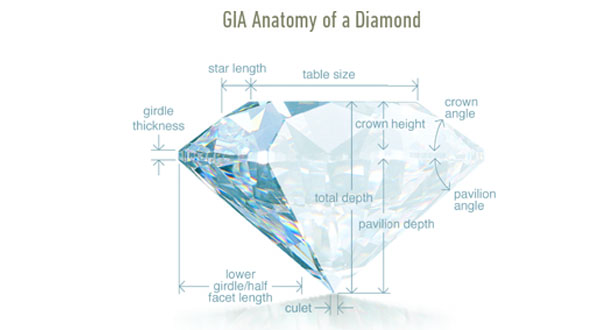
THE CUTTING PROCESS
Cutting diamonds requires much experience, skill, and patience. Cutters apprentice for many years under the watchful eye of a Master. A rough diamond will be passed through many hands on its journey to the final polish.
The first step in the cutting process is marking the rough. The cutter will plan the cutting of the rough and mark it accordingly. He will determine what inclusions can be eliminated, how well the stone will be proportioned and how large the final gem will be.
After marking, the stone will be given to a cutter for splitting either by a process known as cleaving (splitting the stone parallel to the grain) or sawing (splitting the stone by sawing through the crystal against the grain). Sawing is a difficult process that can take several hours and literally be done one millimeter at a time.
The next step in the process is called bruting or rounding. This is when the girdle will be shaped and the cone that will become the pavilion is fashioned. The cutter tries to retain as much of the rough as possible in keeping with the original goals. The result could be that the diamond has something called a girdle natural which is retention of part of the original skin of the rough to eliminate unnecessary loss of weight, and is considered the mark of good craftsmanship.
The next step is performed by the blocker. This is when the culet, the four bezel facets on the crown, and the four pavilion mains are fashioned. The rest of the faceting is accomplished in the step called brillianteering which adds 24 crown facets and 16 pavilion facets.
Lastly the diamond will be ready for its final polish when any external blemishes like girdle fringing is removed and the diamond is finished as the beautiful gem that will out-shine all others.
COLOR
Color refers to the actual body color (the color of the material itself) of the diamond. This is different from the play of color (the flashes of rainbow colors) that results from dispersion. Diamonds will range from colorless (D on the scale) to yellow to brown (Z on the scale), with only very slight tinges of color separating each grade in between. Without a set a guide stones for comparison, it is very difficult to discern color differences or to see color in a mounted stone through I color. Most diamonds are shades of white to yellow to brown, however, there is a rare classification of diamonds called fancies that come in a wide variety of colors.

While diamonds are 99.95% simple carbon in composition, the presence of certain trace elements will create color in a diamond. The presence of nitrogen will create yellow in a diamond. Boron causes a diamond to be blue. The Hope Diamond is the number one most visited exhibit in the Smithsonian. Its mysterious legend and rich blue color make this 45.52 cushion cut diamond an object that people have admired for many years. The rarest of the fancy diamonds is red of which only 10 are known to exist in the world. Blue is the next most rare. Pink is also very rare and the recent highly publicized celebrity engagements with pink diamonds have created more awareness and desire for pink stones.
The best way to think of colorless is to imagine a drop of pure, distilled water; of course, true colorless diamonds are very rare, and therefore, very expensive. D color represents 1% of all diamonds. D-E-F color is considered colorless, G-H-I near colorless, J-K-L slightly tinted. Diamond is the only gemstone where “no color” is the preferred color. Virtually every other gemstone is valued for intensity and saturation of color.
COLOR GRADING
GIA is the most widely accepted system; it is also the most stringent, with a smaller classification at the upper end. View a diamond through the pavilion to see body color (how much yellow or brown).
Differences between D-H in a mounted stone are very difficult to discern.
- D – Absolutely colorless. The highest color grade, which is extremely rare.
- E – Colorless. Only minute traces of color can be detected by an expert gemologist. A rare diamond.
- F – Colorless. Slight color detected by an expert gemologit, but still considered a “colorless” grade. A high quality diamond.
- G-H – Near colorless. Color noticeable when compared to diamonds of better grades, but these grades offer excellent value.
- I-J – Near colorless. Color slightly detectable. An excellent value.
- K-M – Faint yellow.
- N-Z – Very light to light yellow.
ABOUT FLUORESCENCE
A physical property that a diamond may or may not possess. Causes a diamond to appear a different color than it actually is when viewed in certain lights. Actually is a radioactive property.
It can produce a yellowish, bluish, or whitish glow in Sun-light or fluorescent light. Blue is the most common, and it can mask yellow; viewed in incandescent light (normal candle or regular lamp), the diamond will appear yellow, if indeed it is.
Doesn’t add or take away from value. Actually, it makes a diamond look bluish, which enhances color. Diamonds that exhibit strong yellow florescence, however, will be lower in price, since it detracts from the beauty of the stone.
WHAT COLOR GRADE IS THE BEST?
- For the purist, look for a colorless diamond with a grade of D-F and a fluorescence rating of faint, inert, none, or negligible.
- For an excellent value in a diamond with no noticeable color to the unaided eye, look for a near-colorless grade of G-I, and a fluorescence grade of medium or strong blue.
- Or, if you’d rather not compromise on color but would like to stay on budget, choose a diamond with a good cut, SI1–SI2 clarity, and consider going with a strong fluorescence. It will still be beautiful to the unaided eye and you may prefer the unique effect of a strong fluorescence.
NATURAL FANCY COLOR DIAMONDS
Red, pink and blue are extremely rare. Fancy color diamonds are valued for hue, tone, saturation, and intensity. The grading ranges from fancy, fancy light, to vivid. The least valuable but still expensive is black. On 4/28/87, Christies sold a 0.95 purplish red stone with 2 large flaws for $800,000. There are 10 known reds in the world!
IRRADIATED DIAMONDS
Color is artificially enhanced through bombardment in a cyclotron field. Irradiated diamonds are much less expensive. Tests can be done to determine if color was enhanced artificially.
CLARITY
Clarity refers to the presence or absence of certain diamond identifying characteristics, known as inclusions. The location, size, types and color of these inclusions all help to determine where a diamond falls on the clarity grading scale. Clarity is only one characteristic of quality, so don’t use the terms interchangeably. Keep in mind that the higher the clarity, the more rare, and consequently more expensive. Only about 2% of the world’s diamonds are flawless.
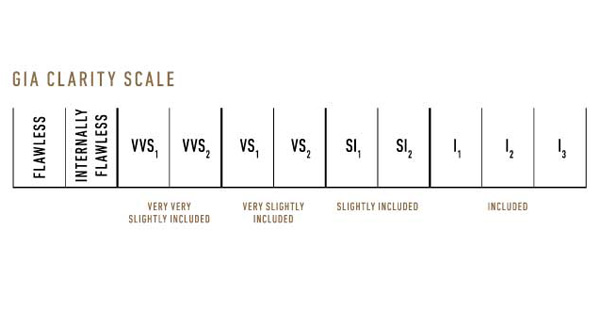
CLARITY GRADING TERMINOLOGY
The most widely accepted standard for clarity grading is the scale developed by the Gemological Institute of America (GIA). Its greater number of classifications makes it the strictest system. (An alternative scale is the AGS, which has slightly fewer classifications.)
- Internally FLawless – No inclusions visible at 10x magnification.
- VVS1 – Minute inclusions, extremely difficult to see at 10x magnification.
- VVS2 – Minute inclusions, very difficult to see at 10x magnification.
- VS1 – Minor inclusions, difficult to see face-up at 10x magnification.
- VS2 – Minor inclusions, somewhat easy to see face-up at 10x magnification.
- SI1 – Noticeable inclusions, easy to see at 10x magnification.
- I1 – Obvious inclusions at 10x, visible to the unaided eye.
- I2 – Obvious inclusions, easily visible to the unaided eye.
- I3 – Prominent inclusions.
CARAT WEIGHT
The more a diamond weighs, all things being equal, the more it will cost. Weight is different than size. A diamond can look bigger and weigh less, depending on how it’s proportioned.

Diamonds are weighed in terms of points and carats. Carat comes from the carob seed, (from a tree in the Mediterranean region) which was a method of measure in ancient times. There are 142 carats to the ounce!
Because of the density difference between gemstones, two stones can appear to be the same size, yet have different weights. For example: Emerald weighs less than diamond, so an emerald that actually weighs 1 carat will look bigger than a 1 carat diamond. On the other hand, ruby weighs more than a diamond, so a ruby that weighs 1 carat will look smaller than a 1 carat diamond. As discussed previously, this is the result in differences in specific gravity.
CARE
Diamonds are the hardest substance on earth. They are uniquely resistant to damage by heat or scratching, and can be cut or polished only by another diamond — but an extremely hard blow to the girdle can cause a diamond to chip. By having your diamond set in a relatively protective setting, and remaining conscious of it on your finger, you can keep your diamond intact for a lifetime. Exposure during ordinary wear to perspiration and household chemicals, like chlorine and hairspray, can cause buildup that dulls the surface of a diamond. We suggest periodic cleanings to keep the diamond brilliant and refractive.
CLEANING YOUR DIAMONDS
A solution of one part ammonia and six parts water can be used to clean diamond jewelry at home. If cleaning by hand, gentle scrubbing with a soft brush should loosen most dirt and greatly increase the brilliance of the diamond, but be careful not to scratch the metal of your setting. Once a year, it is a good idea to have your diamond cleaned and have the security of the setting checked.
STORING YOUR DIAMOND JEWELRY
We recommend that all diamond jewelry is stored individually in soft cloth pouches when not being worn to prevent the diamond or diamonds from scratching or dulling other jewelry.
CLARITY ENHANCED DIAMONDS
OUR UNIQUE WEIGHT-SAVING, SIZE-RETENTION TECHNOLOGY
During the Yehuda clarity enhancement process we insert a microscopic amount of material into the part of the diamond that contains a feather. This material has the same optical properties as the diamond itself. When light travels from one medium to another, it either changes its course or reflects in a different direction. When light attempts to pass through a non-enhanced diamond that has a feather, the light hits the feather and reflects off in any number of directions. That is why we see the feather, and the diamond doesn’t appear to be clean. With a Yehuda diamond, the light passes through the natural feather because the material used for the enhancement has the same optical characteristics as the diamond. The beam of light “thinks” it’s still traveling through the same material (diamond) and continues its original course.
WHO INVENTED THIS CLARITY ENHANCEMENT PROCESS?
In 1982, Zvi Yehuda, an extremely famous Israeli scientist discovered a way to enhance the clarity of diamonds. The revolutionary process optically eliminates “feathers”, which are naturally occurring in most diamonds. The result is a more visually stunning diamond that you can purchase for significantly less then a similar-looking, non-enhanced diamond. Best of all, Yehuda Diamonds are totally natural and come from the same diamond mines as all other diamonds. The clarity enhancement process is not visible to the naked eye. Only your trained jeweler will ever know that you own a natural Yehuda Clarity Enhanced Diamond.
DOES CLARITY ENHANCEMENT “CHANGE” A DIAMOND IN ANY WAY?
No, it is still a natural diamond – it just looks better. The amount of material used to fill the feather is so microscopic that even the world’s greatest diamond laboratory, the Gemological Institute of America (GIA) has reported that Mr. Yehuda’s clarity enhancement process adds ZERO WEIGHT to a diamond. Take a look at the before and after pictures below and judge for yourself.
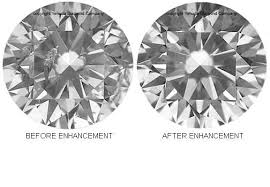
HOW JEWELERS CAN IDENTIFY A YEHUDA DIAMOND.
An enhanced diamond sold by Yehuda Diamond Company has a built-in signature “flash effect.” Easily seen under normal 10X magnification, the flash effect appears as a line of vivid color at the location of the enhancement.
The flash is usually purple or green in color. When jewelers see the flash, they can easily identify the precious stone as a Yehuda Diamond and take the proper precautions of not introducing the stone to the jeweler’s torch or boiling acids or bases – the only things that may effect the enhancement.
Be sure you receive the Yehuda Lifetime Guarantee CD with every purchase of a Yehuda Clarity-Enhanced Diamond. The lifetime guarantee safeguards your purchase and ensures that you have purchased a genuine Yehuda Diamond, not an inferior imitation.
THE FOLLOWING IS THE YEHUDA GUARANTEE…
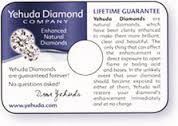
Your Yehuda Diamond is a natural diamond from deep in the heart of the earth which has been technologically enhanced to become as brilliant, clear and beautiful as modern science can make it. The only things likely to compromise the integrity of your diamond’s enhancement are the flame of a torch or boiling acids and bases. In the unlikely event your Yehuda diamond should lose its enhancement, Yehuda will gladly restore the enhancement of your diamond at no charge.
No questions asked.
With each diamond sold, Yehuda provides a unique business card-sized CD, which when played on a standard PC, describes the Lifetime Guarantee.
Be sure you receive the Yehuda Lifetime Guarantee CD with every purchase of a Yehuda Clarity-Enhanced Diamond.
The lifetime guarantee safeguards your purchase and ensures that you have purchased a genuine Yehuda Diamond, not an inferior imitation.
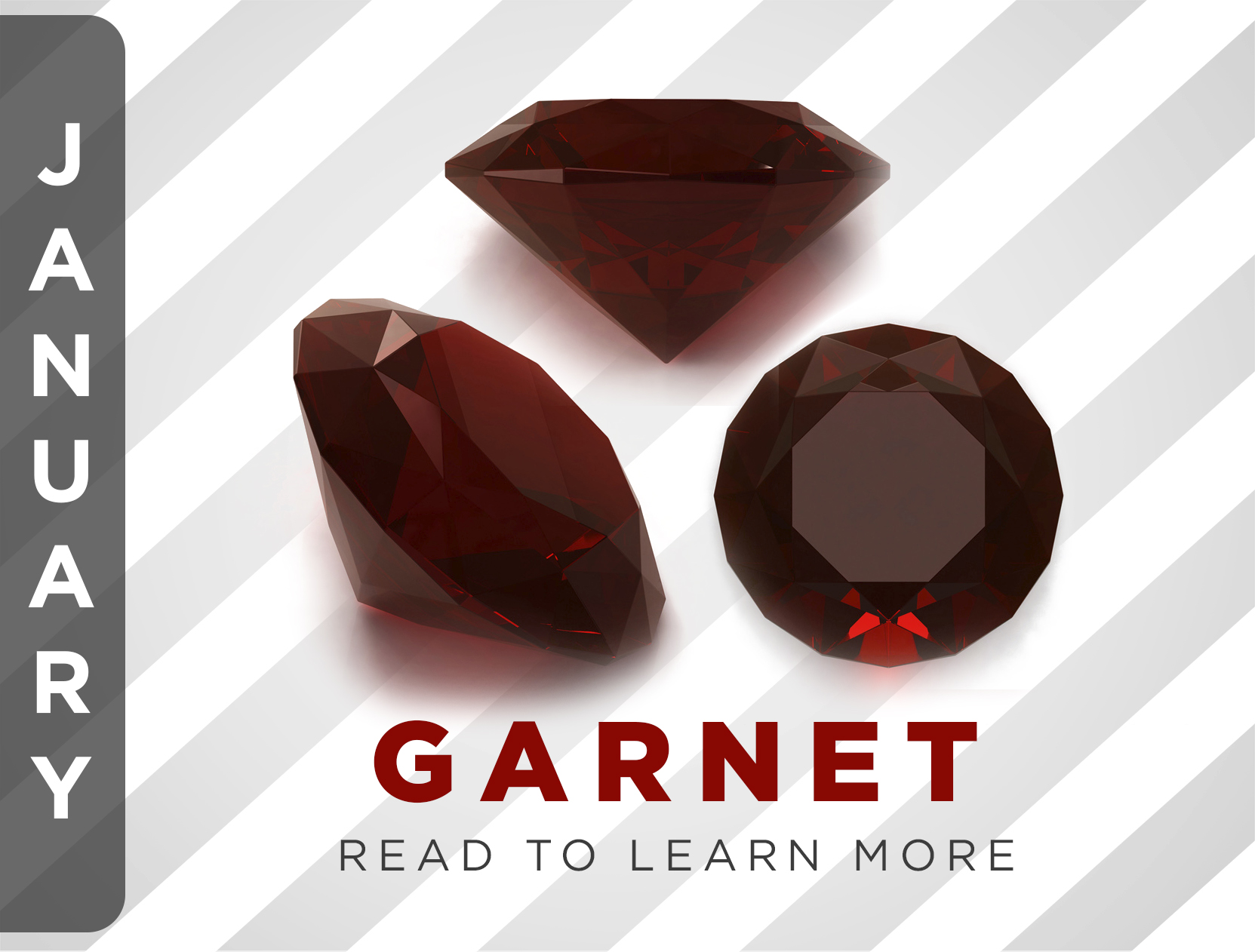
As far back as 3,100 B.C., there are historical references that the Egyptians used garnets in their inlaid jewelry. The word garnet comes from the word granatum, which means seed based on some garnet varieties’ close resemblance to the color of a pomegranate seed. Garnet signifies eternal friendship and trust, making it the perfect gift for a friend. The current leading sources for garnet include Africa, Sri Lanka, and India. Garnet naturally occurs in a number of colors from reddish Pyrope Garnet to Green Garnet from Africa, namely Tsavorite Garnet from Kenya. Garnet is the birthstone of January babies, and is the primary gemstone gift for a second wedding anniversary and an alternate gemstone gift for those celebrating six years of marriage.
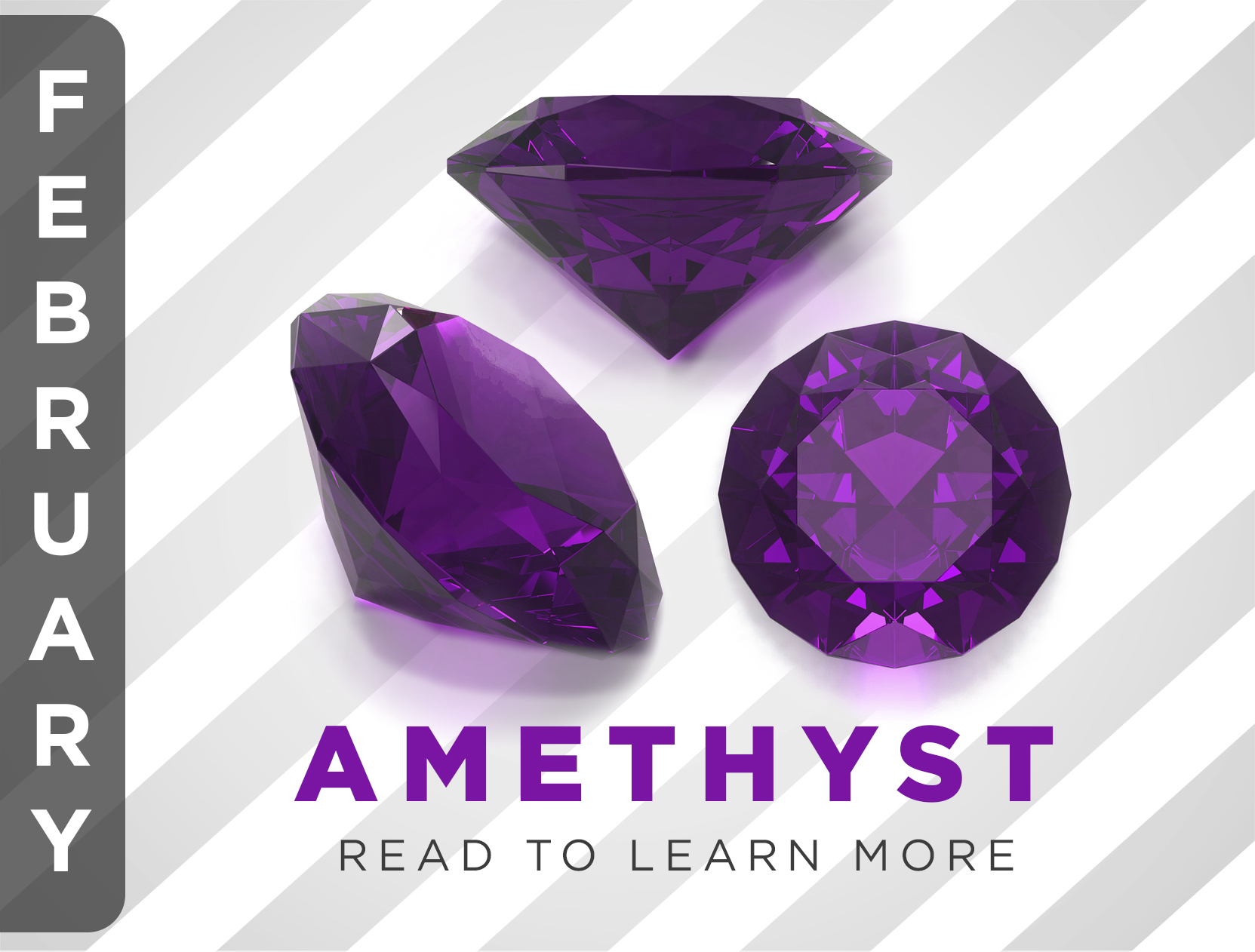
The Bible mentions amethyst as one of the 12 gemstones adorning the breastplate of the high priests of Yahweh. Other references to amethyst in early history include Pliny the Elder that wrote the color of amethyst is similar to the color of wine. Coincidentally, ancient Greeks and Romans believed amethyst could ward off the intoxicating powers of Bacchus, the God of Wine. Although amethyst is found throughout the world, Brazil and Uruguay are the world’s leading sources in terms of quantity and quality brought to market. Amethyst is the perfect gift for February babies, those born under the zodiac sign of Pisces, and couples celebrating their 4th, 6th and 17th wedding anniversaries.

Aquamarine is the blue member of the beryl family of gemstones. The name aquamarine comes from the Latin word aqua, meaning water, and marina, from the sea. Given this history to the gemstone’s name, it’s no surprise that the gemstone was believed to protect sailors, as well as to guarantee a safe voyage. Aquamarine is most often light in tone and ranges from greenish blue to blue-green; the color usually is more intense in larger stones. This gemstone is mined mainly in Brazil, but also is found in Nigeria, Madagascar, Zambia, Pakistan, and Mozambique. The most popular cut for a larger aquamarine is an emerald cut. The birthstone for March babies, aquamarine is an alternate gift for those celebrating 16 years of marriage, and a primary gemstone gift for couples celebrating their 19th anniversary.

April has the King of Birthstones: Diamond. The earliest references to diamonds have been found in Sanskrit documents dating from 300 B.C. Early Greeks believed diamonds were tears of the gods. Diamonds are considered by many to be a modern symbol of love. But the first recorded diamond engagement ring was given to Mary of Burgundy by her fiancé, the Archduke Maximilian of Austria. The world's largest gem diamond ever found is the 3,106-carat (about 1.3 pounds) Cullinan Diamond. Fancy-color diamonds are natural, rare and truly exotic gem of the earth. Diamonds in hues of yellow, red, pink, blue, and green range in intensity from faint to vivid and generally the more saturated the color, the higher the value. Diamonds are for April babies and those celebrating 10th, 60th, and 75th wedding anniversaries.

Emeralds were mined in Egypt as early as 330 B.C. Today, most of the world’s emeralds are mined in Colombia, Brazil, Afghanistan, and Zambia. The Colombian material is considered by many experts to be the world’s top-grade emeralds, particularly goods sourced from the legendary Muzo Mines. Some believe wearing an emerald brings wisdom, growth, and patience. The emerald, a symbol of rebirth, is believed to grant the owner foresight, good fortune, and youth. Give an emerald to those born in May, to couples celebrating their 20th anniversary and emerald is a secondary gemstone gift for those together for 55 years of marriage. Emerald is symbolic of love and fidelity.

Some months have more than one birthstone, which is the case for June. Pearls are the original organic fashion accessory, dating back thousands of years in many countries and cultures. According to ancient Chinese mythology, pearls came from the tears of dragons when the fabled beasts fought. In the Book of Matthew, he writes about “casting pearls before swine.” And, many know of Cleopatra’s famous bet with Marc Anthony when the queen of Egypt crushed a pearl and put it in her drink, proving she could spend the most on a single meal. These lustrous gems are the birthstone for June babies. And, pearls are the primary gift for those celebrating their 3rd and 30th anniversaries, and, are the alternate gifts for couples celebrating their 1st and 12th anniversaries.
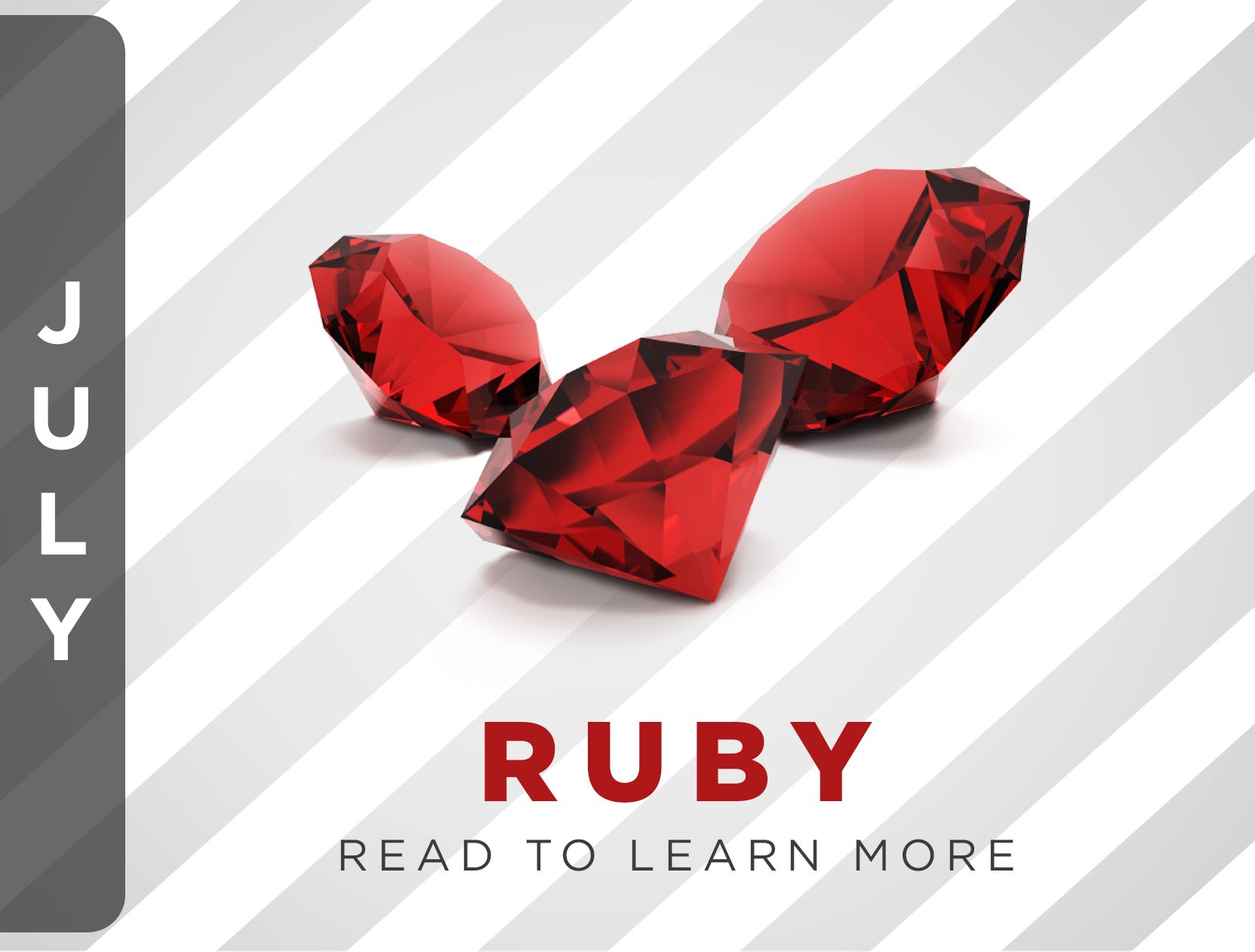
Ruby is known as the “King of Gemstones” for Hindus. And, the Burmese, like some other cultures, believed that rubies came like fruit in nature, either grown in the ground or ripened on trees branches, maturing to a fiery red. Ruby is a favorite gemstone for those in power and in love. Second in hardness to diamonds, rubies inspire boldness and bring success in business. Ancient warriors implanted rubies under their skin to bring valor in battle. For lovers, rubies attract and maintain love and inspire more passion than any other gemstone. And who needs a doctor when rubies are associated with curing diseases of the blood and bleeding as well as relieving pain. For those born in July, ruby makes a great gift. It’s also the most appropriate gift for those celebrating their second and eighteenth anniversaries.
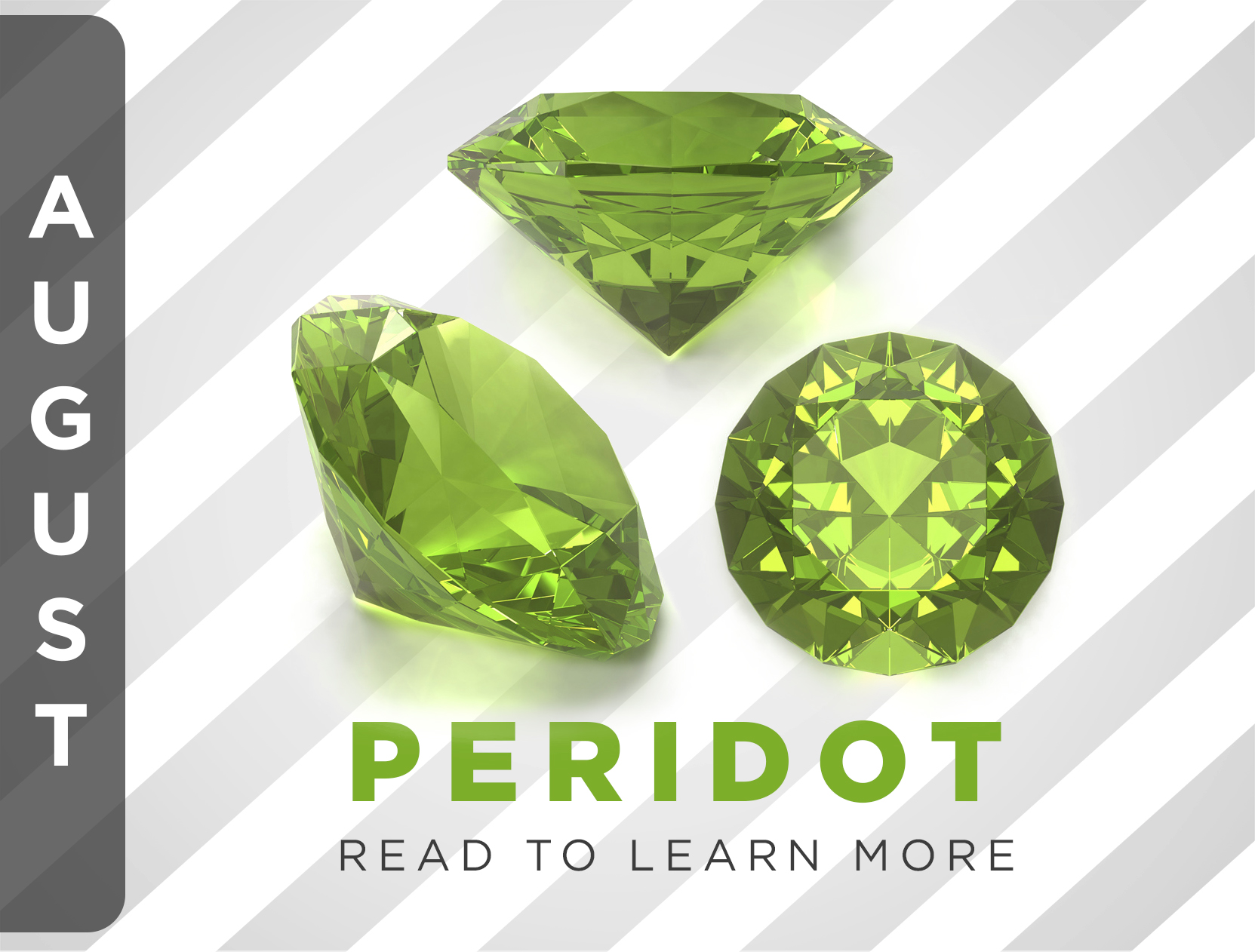
As a member of the olivine family, Peridot is named after the French word for gold (peritot) as some The radiance of peridot allowed workers in ancient times (as far back as 1,500 B.C.) to mine the gemstone at night. Cleopatra’s emeralds were actually peridot mined in Egypt. Peridot promotes friendship and is said to free the mind of envious thoughts. Today, most of the peridot supply comes from Arizona; other sources are China, Burma, and Pakistan. This gemstone comes in several color variations ranging from yellowish green to brown, but most consumers are attracted to the bright lime greens and olive greens. Peridot can naturally occur slightly gold in color. The birthstone for August babies, Peridot is also an appropriate gift for couples celebrating their 16th anniversary.
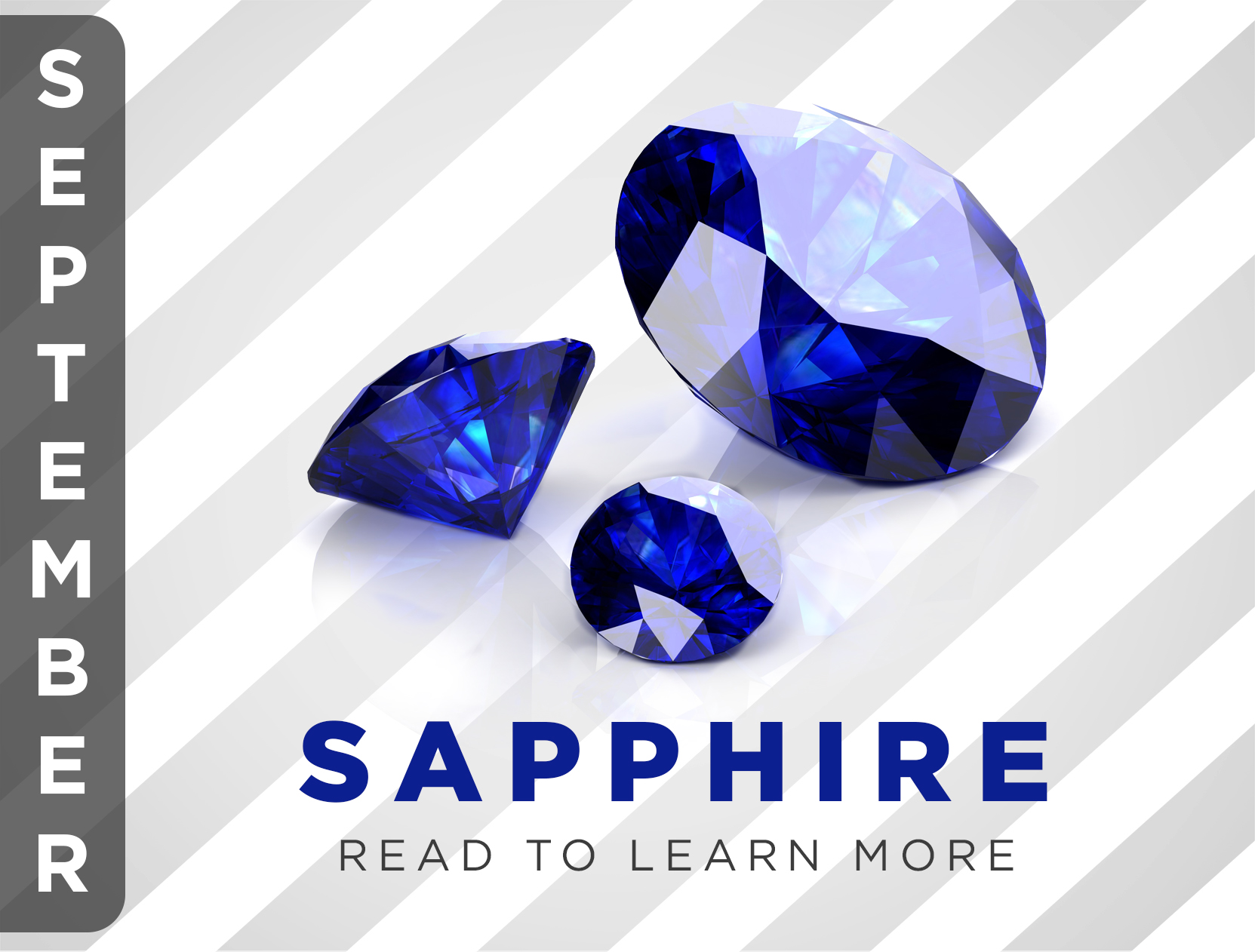
Ruby and sapphire come from the corundum family of gemstones, second only to diamonds in hardness. Ruby is the red variety of corundum and sapphire blue. Sapphires occur naturally in a variety of colors, including yellow, green, white, colorless, pink, orange, brown, purple, and padparadscha (a rare orange-pink variety of sapphire). Wearing a sapphire can bring spiritual enlightenment and inner peace. It’s also believed that sapphires possess healing properties for rheumatism, colic, and mental illness and can enhance powers of psychokinesis, telepathy, clairvoyance and astral projection. More gift-giving options: Sapphire is given as a gem for the 5th, 23rd and 45th wedding anniversaries while a star sapphire is given on the 65th wedding anniversary.

The name opal, October's birthstone, is associated with three main sources: Sanskrit (upala, “precious stone”); Greek (Opallios, “to see a change of color”); and Latin (opalus, “seeing jewel”). In some ancient civilizations, opal was said to have fallen from heaven in flashes of lightening, thus producing opal’s fiery color play. Queen Victoria gave opals as wedding presents while her daughters popularized opals in fashion jewelry; and Napoleon gave Josephine a beautiful opal with brilliant red flashes called “The Burning of Troy.” Opal’s mystical qualities include: being a symbol of hope; opal is linked to invisibility and astral projection; and is able to ward off lightening. Opals can also be given as a gift on a couple’s 14th wedding anniversary.
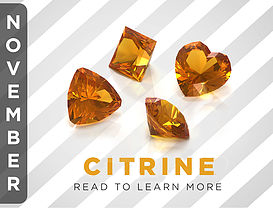
The yellow or orange variety of quartz – it's the November birthstone. Here are some factoids about citrine: It’s an alternate Zodiac stone for Scorpio; Citrine-set jewelry is given as the gemstone gift for the 13th and 17th wedding anniversaries; and, it is associated with the values of hope, cheerfulness, youth, health, and fidelity. Topaz can be found in a large variety of colors such as vivid blue, lush green, soft pink, earthy brown and even transparent. Topaz can be found in many countries throughout the world including the United States.

Soothing and Cool are words often associated with December's birthstone. Blue Topaz was considered by ancient civilizations to have cooling properties. It was believed that it could be added to a pot of boiling water and it would cool it. Others thought that it helped to calm hot tempers as well!
GOLD
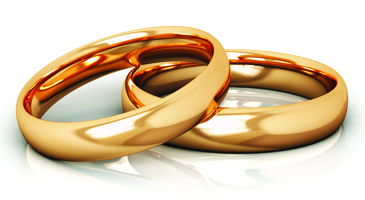
Gold is an excellent medium for jewelry, maleable yet durable, pure and beautiful, with a rich appearance that complements many gemstones. The intrinsic value of gold makes it an excellent choice for any jewelry selection. Most gold jewelry is 58.5% pure gold with numerous other alloy metals making up the remaining percentage to provide additional durability, coloring, and other properties conducive to the purpose. Often alloyed with white metals to change the color to silver(white), even then gold must be plated with a platinum metal to give it a bright white color.
KARAT DEFINITION
The karat system is used to reveal the amount of pure gold found in a piece of jewelry. Solid gold jewelry is not actually solid at all. A portion of the gold is mixed with different alloys. Each shade of gold uses a different combination of alloys. Karat values range from 24K down to 9k. The gold content on anything 8k or less is so low that it wouldn’t be considered solid gold jewelry. Karat is also used on gold filled and gold plated jewelry. Even though these pieces are not solid all the way through, the portion of gold included also has a certain percentage of pure gold.
RANGES OF KARAT VALUES
- 24 karat (24K) gold is pure gold.
- 18 karat (18K) gold contains 18 parts gold and 6 parts another metal or metals, making it 75% gold.
- 14 karat (14K) gold contains 14 parts gold and 10 parts another metal or metals, making it 58.3% gold.
- 10 karat (10K) gold contains 10 parts gold and 14 parts another metal or metals, making it 41.7% gold. 10k gold is the minimum karat designation that can still be called gold in the US.
These values are primarily used on gold from the Unites States. You will see a lot of 22k gold in other countries as well as 9k gold. Jewelry from other countries also has a different set of gold markings they use.
Platinum
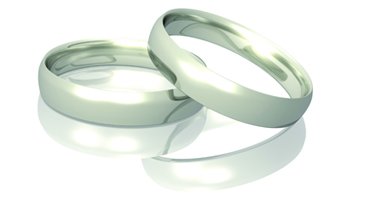
Platinum is an excellent choice for jewelry, with a natural white color that develops a deeper sheen as it ages through wear and use. Platinum jewelry is typically 90-95% pure platinum with the metal alloyed with other Platinum Group metals such as irridium, palladiium, or others. Platinum is an excellent choice for setting diamonds, and is one of the most durable and longest lasting metals used in jewelry manufacturing.
PALLADIUM
Palladium is a Platinum Group metal and is often used as a white metal without the expense of Platinum but is better for stone setting and longevity than Silver.
Silver
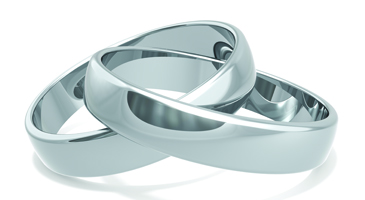
Silver is a very popular white metal, and while it is more abundant and therefore not valued quite as high as its siblings, it is still an excellent choice for jewelry. It is beautiful, durable, and easily worked into intricate and beautiful designs.
WEDDING ANNIVERSARY TRADITIONS
Tradition tells us that each wedding anniversary should be celebrated by giving your loved one a gift made from a different material. Paper symbolizes the first year of marriage, but with each passing year, the gifts become more precious or more rare. This progression is meant to symbolize the growth in a couple’s relationship through the years.
The origins of the traditional list are not known, however some of the traditions are believed to date back to medieval times. Today, we accompany these traditions with a more modern list that not only offers greater variety, but in many cases, puts a higher value on earlier anniversaries. In addition, a list of jewelry and gemstone traditions offers recommendations for those who prefer to adorn their loved one with something truly precious each year.
| YEAR | TRADITIONAL | MODERN | JEWELRY/GEMS |
|---|---|---|---|
| 1st | Paper | Clocks | Gold Jewelry |
| 2nd | Cotton | China | Garnet |
| 3rd | Leather | Crystal/Glass | Pearls |
| 4th | Linen/Silk | Appliances | Blue Topaz |
| 5th | Wood | Silverware | Sapphire |
| 6th | Iron | Wood | Amethyst |
| 7th | Wool/Copper | Desk sets | Onyx |
| 8th | Bronze | Linen/Lace | Tourmaline |
| 9th | Pottery/China | Leather | Lapis |
| 10th | Tin/Aluminum | Diamond Jewelry | Diamond |
| 11th | Steel | Fashion Jewelry | Turquoise |
| 12th | Silk | Pearls | Jade |
| 13th | Lace | Textile/Furs | Citrine |
| 14th | Ivory | Gold Jewelry | Opal |
| 15th | Crystal | Watches | Ruby |
| 20th | China | Platinum | Peridot |
| 25th | Silver | Sterling | Silver Jubilee |
| 30th | Pearl | Diamond | Pearl Jubilee |
| 35th | Coral | Jade | Emerald |
| 40th | Ruby | Ruby | Ruby |
| 45th | Sapphire | Sapphire | Sapphire |
| 50th | Gold | Gold | Gold Jubilee |
| 55th | Emerald | Emerald | Alexandrite |
| 60th | Diamond | Diamond | Diamond Jubilee |







OUR SOCIAL RESPONSIBILITY
Learn what we and other Jewelers are doing to prevent the sale of Conflict Diamonds. All our diamonds have been obtained from reputable sources not involved in the funding of conflict and in accordance with the Kimberly Process.
To learn more, go to www.diamondfacts.org